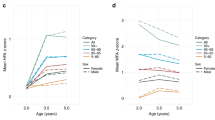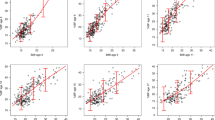Abstract
Background/Objectives:
In 2002, the prevalence of overweight and obesity, defined by body mass index (BMI), was higher in New Zealand Māori (40%) and Pacific (60%) than in European (24%) children; however, this does not take into account interethnic differences in body composition. This study compared trajectories of anthropometric indices from 2004 to 2006 among 5- and 10-year-old Māori and European children.
Subjects/Methods:
In 2004 and then in 2006, 1244 children (639 boys and 605 girls) aged 5 and 10 years had height, weight and fat-free mass (FFM) by bioimpedance measured to derive measures of fat mass (FM), percentage body fat (%BF), FM index (FMI, FM/height2), FFM index (FFMI, FFM/height2), and s.d. scores for BMI and %BF and BMI categories by International Obesity Task Force criteria.
Results:
Body composition and growth in Māori children is different from European children. Over 2 years, the BMI and %BF s.d. scores in both 5- and 10-year-old cohorts increased more in Māori children than in European children. The prevalence of overweight and obesity also increased within ethnicity and age group. The relative change of FMI and FFMI differed by age group, gender and ethnicity. In Māori girls, the magnitude of the changes between 10 and 12 years of age was most marked—the major contribution was from an increase in FMI. At 12 years, the mean %BF of Māori girls was 31.7% (95% confidence interval (CI): 30.1 and 33.3) compared with that of European girls (28.0%; 95% CI: 27.0 and 29.0).
Conclusions:
FM and FFM measures provide a more appropriate understanding of growth and body composition change in children than BMI, and vary with gender and ethnicity. Thus, FMI and FFMI should be tracked and compared among populations.
This is a preview of subscription content, access via your institution
Access options
Subscribe to this journal
Receive 12 print issues and online access
$259.00 per year
only $21.58 per issue
Buy this article
- Purchase on Springer Link
- Instant access to full article PDF
Prices may be subject to local taxes which are calculated during checkout

Similar content being viewed by others
References
Biro FM, Khoury P, Morrison JA (2006). Influence of obesity on timing of puberty. Int J Androl 29, 272–277; discussion 286–290.
Blair NJ, Thompson JM, Black PN, Becroft DM, Clark PM, Han DY et al. (2007). Risk factors for obesity in 7-year-old European children: the Auckland Birthweight Collaborative Study. Arch Dis Child 92, 866–871.
Cali AM, Caprio S (2008). Obesity in children and adolescents. J Clin Endocrinol Metab 93, S31–S36.
Cole TJ (2004). Children grow and horses race: is the adiposity rebound a critical period for later obesity? BMC Pediatr 4, 6.
Cole TJ, Flegal KM, Nicholls D, Jackson AA (2007). Body mass index cut offs to define thinness in children and adolescents: international survey. BMJ 335, 194.
Craig E, Anderson P, Jackson C (2008). The Health Status of Children and Young People in Waikato DHB. Child and Youth Epidemiology Service: Auckland, New Zealand, pp 1–319.
Demerath EW, Schubert CM, Maynard LM, Sun SS, Chumlea WC, Pickoff A et al. (2006). Do changes in body mass index percentile reflect changes in body composition in children? Data from the Fels Longitudinal Study. Pediatrics 117, e487–e495.
Eissa MA, Dai S, Mihalopoulos NL, Day RS, Harrist RB, Labarthe DR (2009). Trajectories of fat mass index, fat free-mass index, and waist circumference in children: Project HeartBeat!. Am J Prev Med 37, S34–S39.
Fogelholm M (2010). Physical activity, fitness and fatness: relations to mortality, morbidity and disease risk factors. A systematic review. Obes Rev 11, 202–221.
Freeman JV, Cole TJ, Chinn S, Jones PR, White EM, Preece MA (1995). Cross sectional stature and weight reference curves for the UK. Arch Dis Child 73, 17–24.
Graham D, Appleton S, Rush E, McLennan S, Reed P, Simmons D (2008). Increasing activity and improving nutrition through a schools-based programme: Project Energize. 1. Design, programme, randomisation and evaluation methodology. Public Health Nutr 11, 1076–1084.
Hattori K, Tatsumi N, Tanaka S (1997). Assessment of body composition using a new chart method. Am J Hum Biol 9, 573–578.
Hopkins WG, Marshall SW, Batterham AM, Hanin J (2009). Progressive statistics for studies in sports medicine and exercise science. Med Sci Sports Exerc 41, 3–13.
Lancet editorial. Curbing the obesity epidemic. Lancet, 2006 367, 1549.
Lawlor DA, Chaturvedi N (2006). Treatment and prevention of obesity--are there critical periods for intervention? Int J Epidemiol 35, 3–9.
McCarthy HD, Cole TJ, Fry T, Jebb SA, Prentice AM (2006). Body fat reference curves for children. Int J Obes (Lond) 30, 598–602.
McLean RM, Hoek JA, Buckley S, Croxson B, Cumming J, Ehau TH et al. (2009). ‘Healthy eating - healthy action’: evaluating New Zealand's obesity prevention strategy. BMC Public Health 9, 452.
Ministry of Education (2007). Deciles Information. Ministry of Education: Wellington. http://www.minedu.govt.nz/NZEducation/EducationPolicies/Schools/SchoolOperations/Resourcing/OperationalFunding/Deciles/ReviewOfDecilesGeneralInformation.aspx (accessed July 2010).
Ministry of Health (2003a). NZ Food NZ Children, Key Results of the 2002 National Children′s Nutrition Survey. Ministry of Health: Wellington.
Ministry of Health (2003b). A Portrait of Health: Key Results of the 2002/2003 New Zealand Health Survey. Ministry of Health: Wellington.
Ministry of Health (2008). A Portrait of Health: Key Results of the 2006/07 New Zealand Health Survey. Ministry of Health: Wellington.
Rush E, Gao W, Funaki-Tahifote M, Ngamata R, Matenga-Smith T, Cassidy M et al. (2010). Birth weight and growth trajectory to six years in Pacific children. Int J Pediatr Obes 5, 192–199.
Rush EC, Puniani K, Valencia ME, Davies PSW, Plank LD (2003). Estimation of body fatness from body mass index and bioelectrical impedence: comparison of New Zealand European, Maori and Pacific Island children. Eur J Clin Nutr 57, 1394–1401.
Rush EC, Freitas I, Plank LD (2009). Body size, body composition and fat distribution: comparative analysis of European, Maori, Pacific Island and Asian Indian adults. Br J Nutr 102, 632–641.
Simmons D, Brier BH (2000). Do polynesians have obesity-driven fuel-mediated teratogenesis? Diabetes Care 23, 1855–1857.
Steele RM, Brage S, Corder K, Wareham NJ, Ekelund U (2008). Physical activity, cardiorespiratory fitness, and the metabolic syndrome in youth. J Appl Physiol 105, 342–351.
VanItallie TB, Yang MU, Heymsfield SB, Funk RC, Boileau RA (1990). Height-normalized indices of the body′s fat-free mass and fat mass: potentially useful indicators of nutritional status. Am J Clin Nutr 52, 953–959.
Waikato District Health Board and the Waikato Clinical School (2008). Project Energize ‘Happy Healthy Children of All Shapes and Sizes’. Waikato District Health Board and the Waikato Clinical School: Hamilton.
Wells JC (2000). A Hattori chart analysis of body mass index in infants and children. Int J Obes Relat Metab Disord 24, 325–329.
Wells JC (2001). A critique of the expression of paediatric body composition data. Arch Dis Child 85, 67–72.
Williams SM, Goulding A (2009). Patterns of growth associated with the timing of adiposity rebound. Obesity (Silver Spring) 17, 335–341.
Wright CM, Emmett PM, Ness AR, Reilly JJ, Sherriff A (2010). Tracking of obesity and body fatness through mid-childhood. Arch Dis Child 95, 612–617.
Acknowledgements
The Waikato District Health Board funds the Project Energize programme and its evaluation. This work would not have been possible without the collaboration, guidance and support of the Project Energize team, which includes Sport Waikato, the Waikato District Health Board, Principals, teachers, children and their parents and Energizers.
Author information
Authors and Affiliations
Corresponding author
Ethics declarations
Competing interests
The authors declare no conflict of interest.
Rights and permissions
About this article
Cite this article
Rush, E., Reed, P., McLennan, S. et al. Tracking of body mass indices over 2 years in Māori and European children. Eur J Clin Nutr 66, 143–149 (2012). https://doi.org/10.1038/ejcn.2011.130
Received:
Revised:
Accepted:
Published:
Issue Date:
DOI: https://doi.org/10.1038/ejcn.2011.130
Keywords
This article is cited by
-
Etiology of Obesity Over the Life Span: Ecologic and Genetic Highlights from New Zealand Cohorts
Current Obesity Reports (2014)



